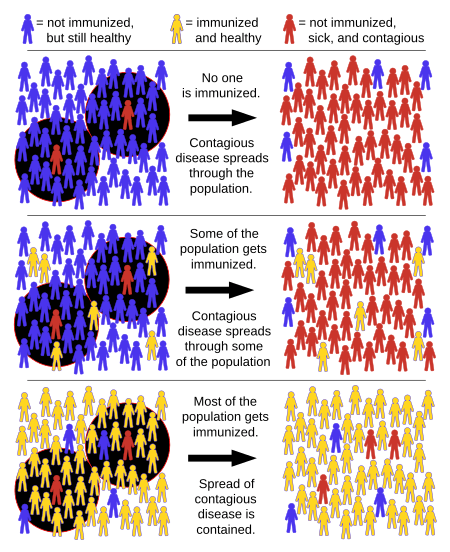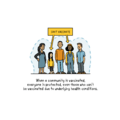Herd immunity facts for kids
Herd immunity is a way a community protects itself from infectious diseases. It happens when a large number of people in a group become immune to a sickness. This immunity can come from having had the illness before or from getting a vaccination.
When many people are immune, they cannot spread the disease easily. This helps to stop or slow down how fast the sickness moves through a population. It protects people who cannot get vaccinated, like babies or those with weak immune systems.
Contents
How Herd Immunity Works
Herd immunity protects a community like a shield. Imagine a disease trying to spread. If most people it meets are immune, the disease hits a "dead end." It can't find enough people to infect to keep spreading widely.
Stopping Disease Spread
When enough people are immune, the chain of infection breaks. This means the disease can't jump from one person to another very well. It becomes harder for the sickness to cause a big outbreak.
Protecting Vulnerable People
Herd immunity is very important for people who cannot get vaccinated. This includes very young babies, people with certain health conditions, or those undergoing medical treatments. These people rely on the immunity of others around them to stay safe from diseases.
Achieving Herd Immunity
There are two main ways a community can reach herd immunity: through natural infection or through vaccination.
Natural Infection
When many people get sick with a disease and then recover, their bodies often become immune to that specific illness. However, relying on natural infection to achieve herd immunity can be very risky. It means many people would get sick, and some might become very ill or even die.
Vaccination Programs
Vaccines are a much safer way to build herd immunity. A vaccine teaches your body how to fight a disease without actually getting sick. When a large percentage of people get vaccinated, they become immune. This quickly builds up protection for the whole community without the dangers of widespread illness.
Examples of Herd Immunity in Action
History shows us how powerful herd immunity can be, especially with vaccines.
Measles and Polio
Diseases like measles and polio used to cause serious problems and many deaths. After widespread vaccination programs, these diseases became very rare in many parts of the world. This is a clear example of herd immunity working.
Rinderpest Eradication
Rinderpest was a deadly disease that affected cattle. Through a global vaccination effort, this animal disease was completely wiped out. The last confirmed case was in Kenya in 2001, and the disease was officially declared gone in 2011. This shows that herd immunity can even lead to the eradication of a disease.
Images for kids
-
A cow with rinderpest in the "milk fever" position, 1982. The last confirmed case of rinderpest occurred in Kenya in 2001, and the disease was officially declared eradicated in 2011.
-
Measles vaccine coverage and reported measles cases in Eastern Mediterranean countries. As coverage increased, the number of cases decreased.
-
Measles cases in the United States before and after mass vaccination against measles began.
See also
 In Spanish: Inmunidad de grupo para niños
In Spanish: Inmunidad de grupo para niños






